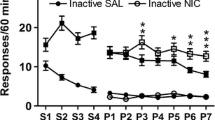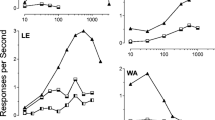Abstract
Intravenous nicotine maintained substantial responding on the drug-reinforced lever with a limited-access, fixed-ratio 5 schedule of self-administration. Responding demonstrated the expected pharmacological sensitivity; it was dose-dependently reduced by pre-session treatment with either nicotine or mecamylamine but not with hexamethonium. In addition, responding was dependent on the size of the unit dose, with maximum values occurring at 0.01 and 0.03 mg/kg/infusion. Self-administration behavior decreased at doses both above and below these, and extinction followed the substitution of saline for nicotine. Total session drug intake increased with unit dose up to a maximal value of approximately 0.5 mg/kg at 0.03 mg/kg/infusion, but did not increase further at the 0.06 mg/kg/infusion dose. A decrease in the time-out duration at the dose of 0.03 mg/kg/infusion also did not change the total session intake of nicotine. It is suggested that nicotine intake is controlled both by the total amount of drug obtained and by the magnitude of the unit dose. These results demonstrate that intravenous nicotine can maintain substantial self-administration behavior in rodents.
Similar content being viewed by others
References
Beardsley PM, Lemaire GA, Meisch RA (1978) Ethanol-reinforced behavior of rats with concurrent access to food and water. Psychopharmacology 59:7–11
Canadian Council of Animal Care (1980) Guide to the care and use of experimental animals. Ottawa, p 84
Clarke PBS (1987) Nicotine and smoking: a perspective from animal studies. Psychopharmacology 92:135–143
Clarke PBS, Fu DS, Jakubovic A, Fibiger HC (1988) Evidence that mesolimbic dopaminergic activation underlies the locomotor stimulant action of nicotine in rats. J Pharmacol Exp Ther 246:701–708
Collins RJ, Weeks JR, Cooper MM, Good PI, Russell RR (1984) Prediction of abuse liability of drugs using IV self-administration by rats. Psychopharmacology 82:6–13
Corrigall WA (1987) Heroin self-administration: effects of antagonist treatment in lateral hypothalamus. Pharmacol Biochem Behav 27:693–700
Corrigall WA, Vaccarino FJ (1988) Antagonist treatment in nucleus accumbens or periaqueductal grey affects heroin self-administration. Pharmacol Biochem Behav 30:443–450
Corrigall WA, Herling S, Coen KM (1988) Evidence for opioid mechanisms in the behavioral effects of nicotine. Psychopharmacology 96:29–35
Cox BM, Goldstein A, Nelson WT (1984) Nicotine self-administration in rats. Br J Pharmacol 83:49–55
Ettenberg A, Pettit HO, Bloom FE, Koob GF (1982) Heroin and cocaine intravenous self-administration in rats: mediation by separate neural systems. Psychopharmacology 78:204–209
Goldberg SR, Spealman RD, Goldberg DM (1981) Persistent behavior at high rates maintained by intravenous self-administration of nicotine. Science 214:573–575
Hanson HM, Ivester CA, Morton BR (1979) Nicotine self-administration in rats. In: Kraznegor NA (ed) Cigarette smoking as a dependence process. NIDA Res Monogr 23. Alcohol, Drug Abuse and Mental Health Administration, Rockville, MD, pp 70–90
Henningfield JE, Goldberg SR (1983) Nicotine as a reinforcer in human subjects and laboratory animals. Pharmacol Biochem Behav 19:989–992
Henningfield JE, Miyasato K, Jasinski DR (1983) Cigarette smokers self-administer intravenous nicotine. Pharmacol Biochem Behav 19:887–890
Kozlowski LT, Herman CP (1984) The interaction of psychosocial and biological determinants of tobacco use: more on the boundary model. J App Soc Psychol 14:244–256
Lang WJ, Latiff AA, McQueen A, Singer G (1977) Self-administration of nicotine with and without a food delivery schedule. Pharmacol Biochem Behav 7:65–70
Latiff AA, Smith LA, Lang WJ (1980) Effects of changing dosage and urinary pH in rats self-administering nicotine on a food delivery schedule. Pharmacol Biochem Behav 13:209–213
Meisch RA, Beardsley P (1975) Ethanol as a reinforcer for rats: effects of concurrent access to water and alternate positions of water and ethanol. Psychopharmacologia 43:19–23
Russell MAH (1987) Nicotine intake and its regulation by smokers. In: Martin WR, Van Loon GR, Iwamoto ET, Davis L (eds) Tobacco smoking and nicotine. Advances in Behavioral Biology, vol 31. Plenum Press, New York, pp 25–50
Singer G, Simpson F, Lang WJ (1978) Schedule induced self-injections of nicotine with recovered body weight. Pharmacol Biochem Behav 9:387–389
Smith LA, Lang WJ (1980) Changes occurring in self administration of nicotine by rats over a 28-day period. Pharmacol Biochem Behav 13:215–220
Yokel RA, Wise RA (1975) Increased lever pressing for amphetamine after pimozide in rats: implications for a dopamine theory of reward. Science 187:547–549
Author information
Authors and Affiliations
Additional information
The views expressed in this manuscript are those of the authors and do not necessarily reflect those of the Addiction Research Foundation
Rights and permissions
About this article
Cite this article
Corrigall, W.A., Coen, K.M. Nicotine maintains robust self-administration in rats on a limited-access schedule. Psychopharmacology 99, 473–478 (1989). https://doi.org/10.1007/BF00589894
Received:
Accepted:
Issue Date:
DOI: https://doi.org/10.1007/BF00589894




